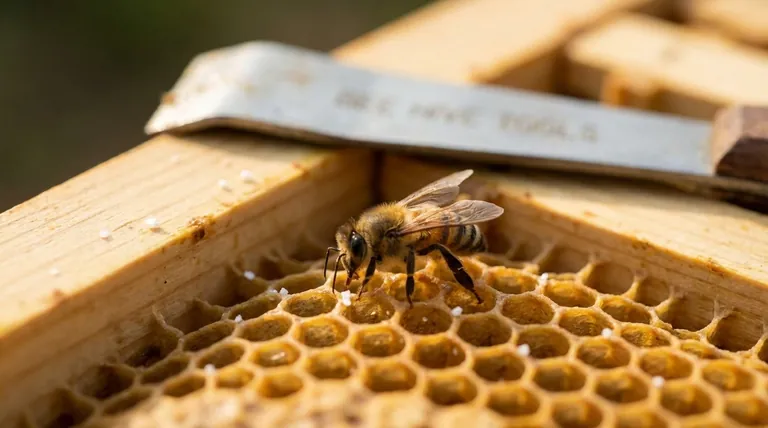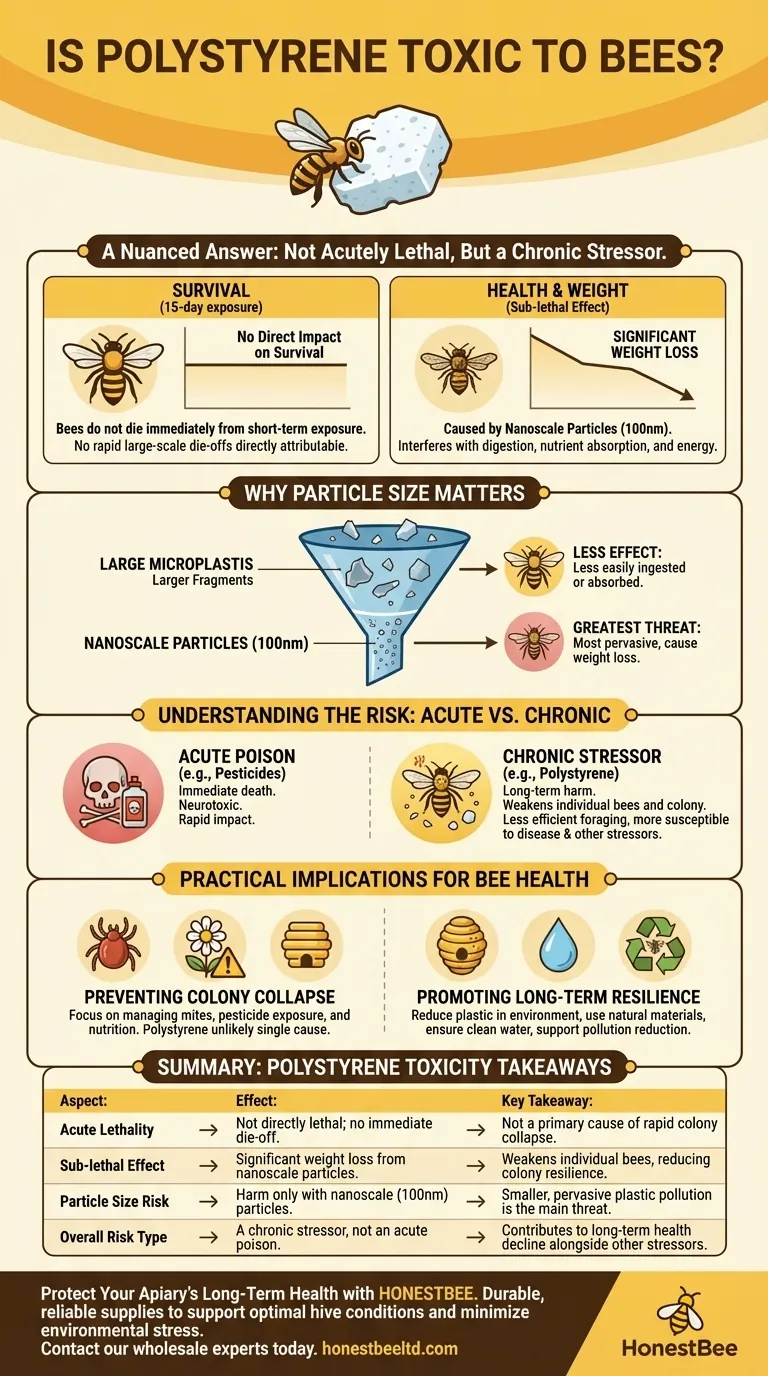Based on current scientific evidence, polystyrene is not acutely lethal to bees, meaning it doesn't kill them on short-term exposure. However, it demonstrates a clear sub-lethal toxic effect, causing significant weight loss in honey bees exposed to nanoscale particles.
The core issue isn't immediate death but a more subtle, chronic harm. Polystyrene microplastics act as a long-term stressor that can weaken individual bees and, by extension, the entire colony, even if it doesn't cause a rapid die-off.

The Nuance of "Toxicity" for Bees
When we ask if something is "toxic," we often think of a fast-acting poison. The relationship between bees and polystyrene is more complex, highlighting the difference between survival and overall health.
Survival Is Not the Whole Story
A key finding is that exposure to polystyrene microplastics, even for 15 days, did not directly impact bee survival rates.
This means that beekeepers are unlikely to see a sudden, large-scale die-off directly attributable to polystyrene exposure alone.
The Sub-lethal Effect: Weight Loss
The true concern lies in the sub-lethal effects. Bees exposed to polystyrene particles at the nanoscale (specifically 100 nm) lost a significant amount of weight.
This is a critical indicator of poor health. It suggests the plastic may interfere with the bee's digestive system, nutrient absorption, or cause an energetic cost to process the foreign material.
Why Particle Size Is Crucial
The negative effect of weight loss was only observed with nanoscale particles.
This implies that the smallest, most pervasive forms of plastic pollution pose the greatest physiological threat. Larger microplastic fragments did not produce the same effect in the study, likely because they are less easily ingested or absorbed by the bee's internal systems.
Understanding the Trade-offs: Acute vs. Chronic Risk
It is essential to frame the risk correctly. Polystyrene is not an immediate crisis for a hive in the way that a pesticide application is, but it represents a persistent, environmental stressor.
Not an Acute Poison
Polystyrene does not act like a neurotoxin or a traditional poison. Its impact is not immediate and may be difficult to isolate from other factors affecting a colony.
A Chronic Health Stressor
The weight loss finding positions polystyrene as a chronic stressor. A weaker, underweight bee is less efficient at foraging, more susceptible to disease, and less resilient to other environmental pressures like pesticides, parasites, and poor nutrition.
Over time, the accumulation of these sub-lethal stressors can compromise the health and productivity of the entire colony.
Practical Implications for Bee Health
Understanding this research helps us make more informed decisions to protect pollinators from an increasingly pervasive threat.
- If your primary focus is preventing immediate colony collapse: Polystyrene exposure is unlikely to be the single cause, and you should continue to prioritize managing mites, pesticide exposure, and ensuring proper nutrition.
- If your primary focus is promoting long-term colony health and resilience: Actively reduce plastic in the bees' environment by opting for natural hive materials, ensuring clean water sources, and supporting broader efforts to reduce plastic pollution.
Recognizing these subtle, sub-lethal threats is the key to safeguarding pollinator populations for the future.
Summary Table:
| Aspect of Toxicity | Effect on Honey Bees | Key Takeaway |
|---|---|---|
| Acute Lethality | Not directly lethal; no immediate die-off. | Not a primary cause of rapid colony collapse. |
| Sub-lethal Effect | Significant weight loss from nanoscale particles. | Weakens individual bees, reducing colony resilience. |
| Particle Size Risk | Harm observed only with nanoscale (100nm) particles. | Smaller, pervasive plastic pollution is the main threat. |
| Overall Risk Type | A chronic stressor, not an acute poison. | Contributes to long-term health decline alongside other stressors. |
Protect Your Apiary's Long-Term Health with HONESTBEE
While polystyrene is a pervasive environmental threat, the foundation of a resilient colony is strong, healthy bees supported by high-quality equipment. The sub-lethal stress of plastic pollution makes it more critical than ever to minimize other stressors.
HONESTBEE supplies commercial apiaries and beekeeping equipment distributors with durable, reliable supplies that support optimal hive conditions. By choosing quality materials for your hives and operations, you help your bees better withstand environmental challenges.
Let's build stronger colonies together.
Contact our wholesale experts today to discuss equipment solutions tailored for the health and productivity of your commercial operation.
Visual Guide

Related Products
- HONESTBEE Advanced Ergonomic Stainless Steel Hive Tool for Beekeeping
- Professional Multi-Function Stainless Steel Hive Tool
- Yellow Plastic Bucket Pail Perch for Beekeeping
- Long Langstroth Style Horizontal Top Bar Hive for Wholesale
- Professional Queen Catcher and Introduction Queen Cage
People Also Ask
- How is a hive tool used for scraping and cleaning? Master Hive Maintenance for a Healthy Colony
- How should beekeepers handle bees when using a hive tool? Master Calm, Deliberate Techniques
- What are some common uses of a hive tool? Essential Multi-Purpose Tool for Every Beekeeper
- Why is it important to compare the progress of different hives? A Beekeeper's Key Diagnostic Tool
- What are the basic tools for beekeeping? Essential Starter Kit for Safe & Successful Hive Management



















